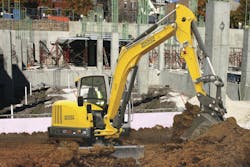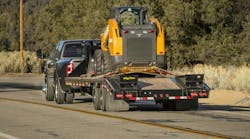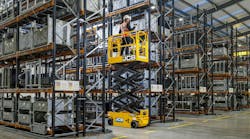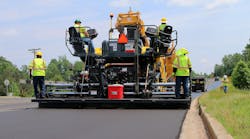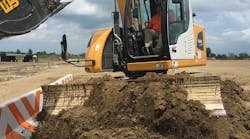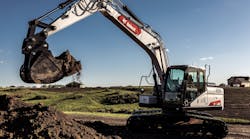“The compact excavator market size has grown significantly within the past 5 years,” says Jordan Dey, compact excavator product specialist for JCB. “Year-to-date compact excavator sales are up 12.8 percent. When we look at this on a more detailed level, the key areas of growth are in landscaping, general construction, and agriculture. However, we are seeing growth in every sector,” Dey says.
Cost of Ownership
Size class (MTons) Avg. price Hourly rate* To 1.0 $25,190 $12.00 1.1-2.0 $32,965 $15.12 2.1-3.0 $43,867 $18.16 3.1-4.0 $50,529 $22.05 4.1-5.0 $66,409 $27.77 5.1-6.0 $69,990 $28.40 * Hourly rate represents the monthly ownership costs divided by 176, plus operating cost. Adjusted operating unit prices used in the calculation are diesel fuel at $2.36 per gallon, mechanic’s wage at $56.67 per hour, and money costs at 2.5 percent.
Source: EquipmentWatch.com
According to Corey Rogers, marketing manager for Hyundai, compact equipment, in a generic sense, is the only major product segment now experiencing sustained growth.
“For compact excavators, specifically, the industry saw 27 percent year-over-year growth in the first quarter of this year, and 10 percent year-over-year growth during the second quarter,” Rogers says. “So, even if the rate of increase is tapering a bit, the increase in unit sales is still significant.
“The ongoing strength of the housing construction market—both single-family and multifamily residential—is helping sustain the growth of the compact excavator segment, with machines being used for utility and landscaping installations, and for jobs in congested and confined workspaces that call for a nimble machine with a small footprint,” Rogers says.
“The compact excavator market is definitely up right now,” says John Comrie, compact excavator product manager at Volvo Construction Equipment. “There were around 27,500 compact excavators sold in 2015 and that number had dropped as low as 10,000 in 2009, so it’s slowly climbed back up.”
There are numerous reasons behind mini excavator popularity. John Deere Commercial Worksite Products division manager Graham Hinch, also representing Hitachi, summarizes why the market continues to grow.
“These machines provide excellent flexibility and versatility so customers can bid and perform a wide range of projects. The machines can get into tighter areas, so customers can get more work done in the smaller lot lines we see today,” he says. “Another benefit is transportation. These machines are easier to move from job to job, which increases utilization and returns for the contractor.”
Katie Pullen, brand marketing manager for Case Construction Equipment, keys on finances in a different way. “When it may not be financially feasible to add a full-sized excavator to a fleet, many companies can add a mini excavator with a lesser effect on the bottom line,” Pullen says.
“High manual labor costs have also contributed to minis’ growing popularity,” says Komatsu’s Kurt Moncini, senior product manager, Tracked Products.
Coupling mini excavators with other compact machines has contributed to sales patterns, as well.
“This upward trend [for mini excavators] started in conjunction with the growing CTL market,” says Warren Anderson, product manager, Excavators & Dumpers, Wacker Neuson. “The advantage of equipping yourself with a mini ex and CTL became more apparent over the last few years, and contractors are starting to lean that way.”
The trend has come at the expense of backhoe-loader sales, manufacturers admit—even those that have made a name for themselves building backhoes.
“There will always be a customer base and natural market for backhoes,” Pullen says. “However, we do see mini excavators cutting into backhoe sales a bit because they do require less investment than a backhoe, all on a lower-horsepower platform. The ultimate deciding factor, as it relates to comparing the excavator functions of each machine, is digging depth.”
Pullen offers a comparison between a larger mini excavator and a traditional industry-standard 14-foot backhoe, pointing out that the mini ex has a maximum digging depth of 12 feet 10 inches, while the backhoe provides 14 feet 9 inches, and 18 feet 3 inches with an optional extended stick. “If a contractor never needs to dig beyond 12 feet and doesn’t require the loader functionality, or they have a skid steer to do that work, then maybe a mini excavator makes more sense,” she says.
“Contractors realized several years ago that spending a few extra dollars for a mini excavator/skid steer loader combination would be more beneficial in the long run, both monetarily and production wise,” says Kendall Aldridge, VP of IHI/Compact Excavator Sales. “A mini excavator/skid steer package is much more productive than a backhoe-loader.” It is worth noting that IHI does not make backhoe-loaders.
“Minis also offer the ability to dig parallel to a wall or structure, which is something backhoe-loaders are unable to do,” Moncini says.
There are other logistical advantages to the mini SSL or mini/CTL combination. “We’re seeing more of a trend where customers prefer to purchase a mini excavator/skid steer combination over a tractor loader backhoe,” says New Holland’s Jon Hundley, construction equipment marketing specialist. “It is easier to haul smaller machines on smaller trailers; the machines can be in different locations working at the same time or on the same site working in tandem. A TLB can only function as a loader or a backhoe, it cannot do both simultaneously.”
In a small-sample-sized survey, 43 percent of respondents told Construction Equipment that they have replaced a backhoe from their fleet with a mini excavator in the last two years. In addition, a large majority, 85 percent, said that despite the large number of manufacturers and models in the category, they do not feel mini excavators have become a commodity purchase.
Last month, Case and New Holland parent CNH Industrial signed a 10-year deal that will enable CNH to manufacture mini excavators in its facilities using the intellectual property of Hyundai. The agreement will result in the next generation of Case and New Holland minis. The mini excavator offering will include 14 models ranging from 1 to 6 tons and will be marketed everywhere but South Korea. CNH will produce models of up to 5 tons at its plants and source models above 5 tons.
Mini excavator rental is also an important acquisition option for managers.
“Construction in many metro areas is strong, and contractors have rented machines rather than purchase to complete projects,” according to Jeff Jacobsmeyer, Kubota’s product manager, Excavators, Tractor Loader Backhoes & Wheel Loaders. “This year, many independent rental yards have added and upgraded equipment to keep up with the increased demand. Many dealer-owned rental yards may offer a ‘Rent to Own’ option and close the sale to the end user this fall.”
If you ask OEMs the percentage of renters versus buyers, the answers—from those who choose to answer—run consistently around 60 percent for sales and 40 percent for rental.
Jacobsmeyer points out that rental percentages can be tracked two different ways. There are sales to independent rental yards only, and sales to independent rental yards and to dealer-owned rental yards. “Since you can only count the sale one time, let’s combine independent yards and dealer rental yards into one number. This year it is roughly 60 percent retail and 40 percent rental,” he says.
“We see that over 60 percent of new machines sales are directly to a rental fleet versus new retail sales to an end user,” says Dan Collins, national sales manager, Kobelco USA. “More and more small- to mid-size contractors are choosing to rent versus own the machines, and we expect this trend to continue. We also see an increase in rent to purchase.
“A short-term rental affords three benefits that generate revenue and build equity,” Collins says. “First, it creates a time frame to assess an excavator’s performance before purchasing. Second, owners who have credit issues can continue building equity in a machine before adding it to a fleet. Third, since owners pay only while using the equipment, rental is a great choice for unexpected projects.”
IHI’s Aldridge says, “I’m seeing more contractors renting, 75 percent, than purchasing, at 25 percent. The contractor realizes that when a unit is rented, the service and maintenance aspects fall solely on the rental store, giving the contractor peace of mind the job they’re working on will be completed without interruptions.”
Deere’s Hinch sees a downward trend. “Rental is a significant part of the business, but has decreased over the years as contractors have found these machines are worth the investment as part of their core fleet,” he says.
When it is time to buy, there are multiple factors to consider, and there’s no shortage of advice from the myriad of OEMs in the category.
Many, of course, cite having the right specs for present and future jobs, transportation, and customer support from dealers. Case’s Pullen breaks it down to three areas: job parameters, track types, and attachments.
“With compact excavators, smaller can be better when working in backyards when the machine has to travel through gates and between obstacles—but the trade-off there can be dig depth,” she says. “Most manufacturers offer a range of machines that help buyers narrow down that sweet spot of access and dig depth.
“Some offer steel tracks, but rubber tracks are more practical for compact excavators in terms of cost and not tearing up the ground,” Pullen says. “It’s also important to understand boom geometry and the tailswing clearance of the machine. This will help determine how closely the operator can work next to buildings and structures.”
Attachment-wise, Pullen says it’s all about the ability to add functionality. “We generally recommend that compact excavator owners add a thumb. Another useful attachment is a hydraulic hammer. While full-sized excavators can handle much larger hammers, a compact excavator matched with a hammer can access more places and help bust through conditions that may otherwise require bringing in a jackhammer,” she says.
“A mini excavator with a compaction attachment is also very useful for compacting trenches and other hard-to-reach areas where it may not be convenient to drop a walk-behind or ride-on compactor,” Pullen says.
“If you’re planning on using attachments,” Volvo’s Comrie adds, “oil flow should be a point of consideration. The more oil flow you need, the more horsepower you’re going to need. Customers should also consider the weight of the machine; their truck can only tow so much weight, so that could restrict the type of excavator they rent or purchase,” Comrie says.
And don’t overlook intangibles important to operators, like feel. “You always want to start with operating weight, dig depth, and overall feel,” Wacker’s Anderson says. “It’s important to pick a unit that can handle the type of digging/trenching that you intend to do on a daily basis. But the feel of the controls is very important. Operators sitting in a mini ex 8 hours a day want to be able to feather the controls and work quickly.”
He also offers a caveat on tail swing. “It is important to understand if you need a conventional tail or zero tail unit,” Anderson says. “Many people lean toward the zero tail because that feature is more sexy than the conventional tail. In reality, if you are not in tight spaces, you have greater digging forces and better stability in a conventional tail.”
Once new mini excavators join the fleet, it’s time to focus on keeping operating costs down. Just because these are small units and fuel is relatively inexpensive right now doesn’t mean managers shouldn’t be keeping a sharp eye on costs. Tom Connor, excavator product specialist for Bobcat, advises managers to begin by making sure operators are prepared. “Start with training. An untrained operator is likely to be less productive on the job if they are not properly trained on the specific machine,” Connor says. “This could be basic functions of this particular make or model, or it could be operational principles of a mini excavator.”
Proper maintenance plays its usual large role in keeping costs down. On mini excavators, pay special attention to the tracks. “Much like larger machines, much of the mini excavator’s cost and maintenance sits in its tracks,” Pullen says. “Whether steel or rubber, the owner should pay the same attention to track life and health that they would to the undercarriage of a dozer or full-sized excavator. This is particularly true with rubber-tracked machines where they may be more susceptible to damage and wear from events like driving over curbs or having mud and snow frozen in the structure overnight. Clean the tracks regularly and watch for uneven wear in the moving parts of the undercarriage that can indicate improper operation, or that a possible failure is in the future. Proactively teach operators the best practices for operating tracked machines that will minimize track wear and maintenance.”
Hyundai’s Rogers stresses sticking with service recommendations. “Once a machine is in the field, the most important consideration for controlling operating costs is following the manufacturer’s and dealer’s recommendations for scheduled maintenance. Using factory-authorized replacement parts also contributes to an efficiently operating machine,” he says.
Kobelco’s Collins says to work with the local dealer for assistance on capturing costs, as well as training. “Through proper use, operators can reduce wear and tear and trim fuel consumption. Even with fuel costs at an all-time low, it is still important to still factor this cost. To project fuel costs, simply multiply the excavator’s consumption rate in gallons per hour by the average cost per gallon,” Collins says. “Multiply that per-hour cost by the total number of hours you operate the machine to provide an estimate of consumption.”
